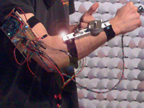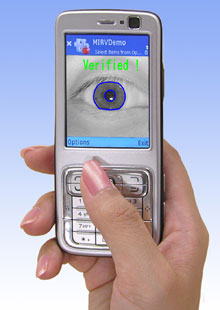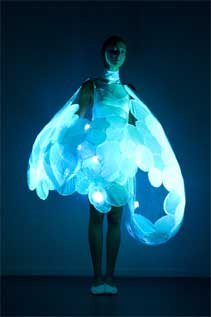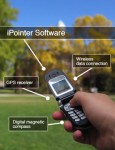Jan 10, 2007
Wirelessly controlled tactile display
Re-blogged from Infoaesthetics

a wirelessly controlled tactile display, consisting of a 4 × 4 array of vibrating motors that is mounted on a waist band or on the forearm. this tactile display can be used as a navigation aid outdoors, as experiments have proved that 8 different vibrotactile patterns can be interpreted as directional (e.g. stop, look left, run, proceed faster or proceed slower) or instructional cues (e.g. "raise arm horizontally", "raise arm vertically", "hop") with almost perfect accuracy.
[link: newscientisttech.com & ieee.org (pdf) springerlink.com|via boingboing.net]
22:05 Posted in Wearable & mobile | Permalink | Comments (0) | Tags: wereable, mobile
Dec 29, 2006
Cell Phone-Linked Breathalyzer
21:48 Posted in Wearable & mobile | Permalink | Comments (0) | Tags: mobile phones
Dec 23, 2006
Future scenario video about UMPCs
The UMPC site has an interesting little future scenario video about how UMPCs might be used
13:39 Posted in Wearable & mobile | Permalink | Comments (0) | Tags: mobile, wereable, mediated social presence
Dec 20, 2006
Mobile Presence
From Networked Performance (via Pasta and Vinegar)

MoPres: Sense and contribute to the ghosty presences around you by Jane Oh, Alex Bisceglie:
MoPres brings out the residual presence of the people who occupied your current location. It is a geotagging project with the humanized `context' of the locations. The raw data is from bio-metric sensers rather than the conscious, forceful, and mostly inaccurate logging which will provide a more creative and sophisticated flexibility of interpretation on the experiences of people
User Scenario: People wear the vest with embedded sensor package [heart rate and body temperature sensors], and the data is logged through the cell phone with geo tagging [gps and/or cell-tower id]. Once the mobile application reads the pattern of the data in relation to locations, it triggers the output devices embedded in the vest [heater and the pulse motor] with relevant residual patterns so that people can experience others' past experiences at the given spot.
22:57 Posted in Wearable & mobile | Permalink | Comments (0) | Tags: mobile, wereable, mediated social presence
Key players in mobile social software
key players in the MoSoSo arena:
Dodgeball, Enpresence, Jambo Networks, Loopt, Mologogo, My MoSoSo, Pinppl, PlaceSite, Plazes, Saki Mobile, Nokia Sensor, Microsoft SLAM, Vixo, Zingku
22:45 Posted in Social Media, Wearable & mobile | Permalink | Comments (0) | Tags: mobile social software
Nov 29, 2006
Driving a Wheelchair with Your Shirt
From Medgadget

Researchers Fishbach and Mussa-Ivaldi at Northwestern University's Department of Physical Medicine and Rehabilitation have developed a high-tech fabric which promises to help wheelchair bound patients.
From the article at MIT Tech Review:
Adaptive, sensor-laden garments could provide a new way for quadriplegics to control their wheelchairs. The system, which is still in an early stage of development, identifies the ideal set of movements that can be employed as control commands for each individual user. "We think this will benefit the most difficult patients, such as those who can move only their head or shoulders," says Alon Fishbach, a scientist at Northwestern who is among those developing the device.
People with high-level spinal-cord injuries often lose control of their hands, but they may still be able to move their shoulders or chests. More and more such patients survive their injuries, thanks to respiratory devices that help them breathe. But these people have limited options when selecting devices to control their wheelchairs or computers. They might use a sip/puff switch, which converts the user's sip or puff of air into a specific command, or a headswitch, which records head movements via a switch on the back of the wheelchair. "But the disadvantage of these devices is that patients must fit the capacities of the machine, rather than the other way around," says Ferdinando Mussa-Ivaldi, another Northwestern scientist working on the device. "If a patient can move their right side more than their left, an intelligent interface could pick up on this."
To overcome this design flaw, the researchers are developing an adaptive device using sensor-laden fabric. The garment is printed with 52 flexible, piezoresistive sensors developed at the University of Pisa. These sensors are made of electroactive polymers that change voltage depending on the angle at which they are stretched. The sensors can detect fine scale movements of the upper body and arms.
The researchers are currently focusing on a system to control wheelchairs, but they say the device could be used to control a wide range of machines.
21:13 Posted in Wearable & mobile | Permalink | Comments (0) | Tags: neurotechnology, wearable
Nov 24, 2006
Mobile virtual worlds
prompted by Layla Nassary Zadeh, I wanted to understand something more about the possibility of implementing augmented reality on mobile devices. Much to my surprise, this field is more advanced than I expected.
For example, a team of researchers from Nokia's Mobile Augmented Reality Applications (MARA) project has created a prototype phone that makes objects in the real world hyperlink to information on the Internet. Using the phone's built in camera, a user can highlight objects on the mobile phone's LCD and pull in additional information about them from the Internet. Moreover, by altering the orientation of the phone, the display will toggle between live view and satellite map view. In map view, nearby real world objects are highlighted for convenient reference.
The prototype consists of Nokia S60 platform phone and attached external sensor box providing position and orientation information to the phone via a Bluetooth connection
This video of downtown Helsinki shows some Virtual Object - associated landmarks, and demonstrates the automatic switching between Augmented Reality mode and Map mode that happens when the user alternates between holding the phone vertically and horizontally.
MARA was demonstrated at the fifth IEEE and ACM International Symposium on Mixed and Augmented Reality in Santa Barbara in October.
20:47 Posted in Virtual worlds, Wearable & mobile | Permalink | Comments (0) | Tags: augmented reality, mobile devices
Nov 08, 2006
Alert driver fatigue wrist device
Via Medgadget
A future concept designed for the AA, this flexible rubber device uses motion combined with reaction time to determine whether or not you are suffering from driver fatigue. The device comunicates with an RFID tag positioned in your car and only starts to detect whether you are tired when you are in your car. The device can be bent to fit your wrist, and has memory to stay in position, to ensure it will not fall off.
Designer: Daniel Ruffle
22:55 Posted in Wearable & mobile | Permalink | Comments (0) | Tags: wereable, mobile
Nov 07, 2006
Talking space
From Textually.org (via Designboom)
Yang Shi Wei and Shawn Wein Shin from Taiwan have designed "Talking Space", a lampshade that creates a space to close off voice during phone conversations

In the designers' own words:
People enjoy the feeling at party. We always hear much sound about laugh, games, music or play... It's good!! Let we relax and excite. Everything is fine. Playing with your friend. But now, your phone is ringing. It maybe tells an important message to you. Can you talk with the other side on noisy place? You need to leave, and try to find another place to close off voice. Going to outside ?! It's just one of way to solve problems. Have another way?
00:17 Posted in Wearable & mobile | Permalink | Comments (0) | Tags: mobile phones
Nov 06, 2006
Iris recognition technology for mobile phones
Re-blogged from Pink Tentacle

Oki Electric announced the development of iris recognition technology for camera-equipped mobile phones. Unlike Oki’s previous iris recognition technology that relies on infrared cameras for the iris scan, the new technology uses ordinary cellphone cameras. With plans to make the technology commercially available in March 2007, Oki hopes to boost the security of cellphone payment systems. According to Oki, any camera-equipped cellphone or PDA can perform iris recognition once the special software is installed. Identification accuracy is said to be high, with only 1 in 100,000 scans resulting in error, and the system can tell the difference between flesh-and-blood eyes and photographs.
23:23 Posted in AI & robotics, Wearable & mobile | Permalink | Comments (0) | Tags: artificial intelligence, mobile phones
Oct 30, 2006
Spoken SMS for the hearing impaired
From Textually.org

According to Tokyomanga, "Japan's Ministry of Health just launched a major collaborative effort with 10+ companies and research institutes to create highly exportable, high-tech devices for people with hearing and vision disabilities, including one that will instantly translate spoken words into cell phone text messages for the hearing impaired"
14:50 Posted in Brain training & cognitive enhancement, Wearable & mobile | Permalink | Comments (0) | Tags: enhanced cognition, mobile phones
Oct 26, 2006
Smart clothing for smart users
10November 2006 - 12 November2006
Amsterdam, Mediamatic
10:00 hr, from 10.11.06 t/m 12.11.06
Oosterdokskade 5
Amsterdam
T 020 638 9901
http://www.mediamatic.net

Tiny chips, cheap sensors and the possibilities of emerging smart fabrics, conductive yarns and cheap wireless communication (bluetooth or even rfid) make wearables easier and cheaper to make. Arduino boards are small physical computing platforms: Arduino developed a fairly simple integrated development environment to deal with the small portable input/output board. With all these tools at our fingertips, nothing is stopping us from making our own smart coats, reactive hats and luminescent skirts.
To help you get started, Mediamatic is organizing a wearables workshop where you can develop your own Arduino-driven wearable. Assisted by Massimo Banzi, one of the creators of the Arduino board and several coding/soldering/sewing helpers, you have three days to make your prototype in the stimulating surroundings of the Mediamatic Winter Garden.
What?
During the workshop, you will design your own wearable. You will define the sensor inputs and the actuator outputs. You will program the Arduino board to react correctly to the different inputs. You will do this in Arduino's own IDE, which helps you write a kind of simplified Java code similar to Processing. Then you will stitch/glue/felt together your prototype so you can participate in the wearables fashion show!
Who?
Computer scientists, fashion designers, hardware hackers, art students, fabric experts, product developers, dancers- everyone is welcome. However, note that some technical affinity is required. Some experience in programming and electronics is useful, specifically in soldering and java, but not strictly necessary. We would advice participants to come in teams of max. 3 people, so you can distribute soldering, coding and sewing tasks.
Where?
The workshop will take place in the latest Mediamatic exhibition: the Winter Garden. The Winter Garden is an indoor botanical garden filled with plants and robots. From the minimalistic electronic creatures of Ralf Schreiber to the virtual forest of Michiel Samyn to the interactive plant by Christa Sommerer and
Laurent Mignonneau to the pheromone tinged garden benches of Mateusz Herczka and the communicative crickets of Felix Hess- the Winter Garden is full of wonders.
What to bring?
If there is a specific sensor or actuator you would like to use during the workshop, we advise you to bring it yourself. You can also bring the actual clothing article beforehand, and not sew it during the workshop, or you can bring fabric and other material for the base of your wearable. You'll have to bring your own laptop to do your coding, and we advise you to download the Arduino software and have a look at it beforehand. Also, bring lunch.
How to prepare?
Besides looking at the Arduino software you can have a look at the Mediamatic wearables reader - a collection of interesting articles, websites and blogposts that can get you started in the world of wearables. Virtual Platform and V2 are organizing a wearables symposium in Rotterdam called Fleshing Out the day before the Mediamatic Arduino workshop with speakers such as Ionat Zurr (SymbioticA: the art and science collaborative research laboratory), Tobie Kerridge (Royal College of Art, London) and Joanna Berzowska (Design and Computation Arts , Concordia University, Montreal).
When?
The Fleshing Out Symposium is on Thursday November 9th at V2. The Mediamatic Arduino Wearables Workshop is from Friday November 10th to Sunday November 12th. The Kiem Cuisine Wearables dinner is Friday at 19:30 at Mediamatic. The Wearables fashion show is Sunday evening at 18:00.
Costs?
The Fleshing out symposium costs 40 euros. Students receive a discount of 20 euros. The Wearable Arduino workshop costs 125 euros. Dutch students receive a discount of 50 euros.
21:50 Posted in Wearable & mobile | Permalink | Comments (0) | Tags: cyberart
Oct 14, 2006
VibePhone
From Pasta and Vinegar
VibeFones: Socially Aware Mobile Phones by Anmol Madan and Alex Pentland will be presented next friday in Montreux, Switzerland for the International Seminar of Wearable Computing.
In this paper, we describe mobile social software that uses tone of voice, location and proximity information to create a sophisticated understanding of people's social lives, by automatically mining their face-to-face and phone interactions. We describe several applications of our system - automatic characterization of social and workplace interactions, a courtesy reminder for phone conversations, and a personal trainer for dating encounters.
18:47 Posted in Telepresence & virtual presence, Wearable & mobile | Permalink | Comments (0) | Tags: mobile, wereable, mediated social presence
Oct 13, 2006
Ovulation watch
|
OV-Watch is an FDA-approved system that is used to predict ovulation. It works through a biochem sensor that detects changes of chloride ions in sweat. According to the producer, the system can predicts ovulation 5 days in advance: Researchers in the late 50s and early 60s noted that numerous salts (chloride, sodium, potassium) in a woman's sweat fluctuated in relation to the menstrual cycle. Chloride levels are low at the start of the menstrual cycle and peak three times during the cycle (see graph below). Using a patented biosensor, OV-Watch detects a baseline chloride ion level for each woman and then accurately predicts ovulation based on the timing of the first peak. The OV-Watch detects the chloride surge 3 days prior to the estrogen surge, 4 days prior to the LH surge and 5 days prior to ovulation, making it an earlier predictor of ovulation than any other chemical surge during the month. During the clinical trials for FDA approval with Dr. Arthur Haney at Duke University, approximately 3 out of 4 women received the full 5 day notice of ovulation while only 1 in 6 women were given more than 12 to 24 hours notice with urine tests or LH kits. For women trying to conceive, knowing the days before ovulation not only lowers the stress level for her and her partner , but it increases her chances of getting pregnant.
|
19:49 Posted in Wearable & mobile | Permalink | Comments (0) | Tags: wereable sensors
Oct 05, 2006
It is still a watch however
The MBW-100 watch lets you answer or reject calls, displays caller ID info, and even lets you play, pause and skip music tracks. The device connects to selected Sony Ericsson handsets (including K790 and K610 models) via Bluetooth 2.0. The stainless-steel, 6.6-ounce watch boasts analog dials and an OLED screen, and it lets you control a variety of phone functions, such as call handling (you can answer, reject or mute calls) and music playback (play, pause, and skip tracks)
22:54 Posted in Wearable & mobile | Permalink | Comments (0) | Tags: wereable, mobile
Oct 01, 2006
SCACS
Re-blogged from information aesthetic

SCACS is a "Social Context-Aware Communication System" that collects information on social networks (i.e. academic co-author relationships networks) & visualizes them on wearable interfaces to facilitate face-to-face communications among people in physical environments. RFID sensors sense the identity of specific people (i.e. authors) nearby, & a wearable computer transforms the complex social network graphs into treemaps, which are then shown as augmented reality on a wearable interface (or head-mounted display).
link: aist-nara.ac.jp (pdf)
12:51 Posted in Augmented/mixed reality, Wearable & mobile | Permalink | Comments (0) | Tags: pervasive technology, augmented reality, mobile computing
Sep 27, 2006
M300: wristwatch GSM phone with SMS
Via Textually.org

The Australian company SMS Development has announced the world's first truly mobile GSM watch phone.
The watchphone has SMS capabilities with an internal antenna, is tri-band and comes with bluetooth functionality; talk time is 80 minutes.
20:15 Posted in Wearable & mobile | Permalink | Comments (0) | Tags: wereable, mobile
Sep 21, 2006
E-garments
Via WMMNA
Philips Design has prototyped two garments that demonstrate how electronics can be incorporated into fabrics and clothes to express the emotions and personality of the wearer.
Bubelle, the "blushing dress" comprises two layers, the inner one is equipped with sensors that respond to changes in the wearer's emotions and projects them onto the outer textile. It behaves differently depending on who is wearing it. The other prototype is Frison, a body suit that reacts to being blown on by igniting a private constellation of tiny LEDs. Both measure skin signals and change light emission through biometric sensing technology.


Design Probe is an in-house far-future research program that considers what lifestyles might be like in 2020.The SKIN probe project is part of the program and challenges the notion that our lives are automatically better because they are more digital. It looks at more 'analog' phenomena like emotional sensing, exploring technologies that are 'sensitive' rather than 'intelligent'. Two outfits have been developed as part of SKIN to identify a new way of communicating with those around us by using garments as proxies to convey deep feelings that are difficult to express in words.
The Bubelle - Blush Dress comprises two layers, the inner layer of which is equipped with sensors that respond to changes in the wearer's emotions and projects them onto the outer textile. The body suit Frisson has LEDs that illuminate according to the wearer's state of excitement. Both measure skin signals and change light emission through biometric sensing technology.
Download images here
Read the full press release
10:35 Posted in Emotional computing, Wearable & mobile | Permalink | Comments (0) | Tags: emotional computing, wearable
Sep 18, 2006
QuitKey Smoking Cessation Computer
Via Mindware
QuitKey is a small portable device that promises to help quit smoking:
This small device, which resembles an automobile keyless remote containing a computer that collects data on the test subject's smoking habits for one week. The computer implements a gradual rate reduction protocol targeting both the physiological dependence on nicotine and conditioned stimuli that may trigger the urge to smoke. QuitKey� cues the individual when it is time for him or her to smoke, based on their history. In reality, what it is trying to do is take away the natural instinct to smoke on impulse, instead teaching the women to smoke on a gradually diminishing schedule.
The device was recently tested in a small-scale pilot clinical study by tobacco-addiction researcher Monica Scheibmeir.
For the study, 10 participants were given a QuitKey, which was attached to a cigarette lighter. Every time the participant reached for the lighter, she was prompted to input data into the QuitKey. According to Scheibmeir, early results are promising.
20:40 Posted in Persuasive technology, Wearable & mobile | Permalink | Comments (0) | Tags: persuasive technology, cybertherapy
Aug 06, 2006
iPointer
Via Textually.org

iPointer is a location-based application developed by Intelligent Spatial Technologies, which allows delivering on-demand information about the user location and surroundings.
From the company website:
"When users wish to identify a landmark, they point the hand-held device and press a button. The iPointer device receives coordinate signals from GPS satellites and orientation information from the digital magnetic compass to identify the user's location and device's pointing angle. These coordinates are then sent over the wireless network to the database. iST's geospatial database's selection algorithms identify the selected landmark and sends information back over the wireless network to be displayed in text, visuals and audio on the user's device"
20:28 Posted in Pervasive computing, Wearable & mobile | Permalink | Comments (0) | Tags: pervasive computing













